Prof. Xiao Lin ZHAO, management committee of RILS, Sr Prof. Ben CHAN, Adjunct Professor of RILS, and Dr Daniel ELKIN, member of RILS, formed a research group to visit Tai O Village on Thursday 25 October 2023. They also invited Prof. Shenjing HE and Dr Junxi QIAN from The University of Hong Kong (HKU) to join the field visit.
This visit was facilitated by Mr Wai Hung LO (盧偉雄), the son of a prominent builder Mr Shu Shing LO (盧樹勝) who had contributed to the construction of numerous stilt houses in the village. The purpose of their excursion was to gain comprehensive insights into the geography, living style, culture, and architecture of Tai O Village and stilt houses, with the additional objective of exploring possibilities for collaborative research.

Tai O Rural Committee Historic and Cultural Showroom

Breakwater wall built in 2013 to prevent future flooding

Group photo taken inside the stilt house of Mr LO (first on the right)
The field visit provided the group with a deeper understanding of the living environment, habitat, culture, beliefs, and economic activities within Tai O Village. They explored the distinctive cultural characteristics of the water village and identified its potential for conservation and development. Stilt house villagers prefer remaining in proximity to the river environment despite offers of access to public housing on land. Stilt house residents display high levels of tolerance for their physical housing conditions, whose difficulties include flooding and underdeveloped sanitation. However, stilt houses may benefit from maintenance and improvements to address concerns related to structural degradation, hygiene, inconvenience caused by flooding, inadequate infrastructure, employment, and lack of opportunities for their livelihood.
Moreover, the excursion unveiled promising opportunities for collaborative research endeavors. These included the design and construction of innovative floating solutions to modernize stilt houses while simultaneously preserving the cultural heritage of Tai O Village, and implementing preventive measures to counteract decay within the village to provide resilience among people. Tai O's stilt houses were deemed an ideal research site for integrating civil infrastructure and social infrastructure development, offering solutions for stilt houses, safeguarding habitats and heritage, establishing a test bed for floating construction, and even providing entertainment facilities, hotel accommodations to promote tourism and augment the village's economic value. It is necessary to discuss a holistic approach to consider the overall development of Tai O village and surrounding waters through cross-disciplinary collaborations among researchers in civil and environmental engineering, architecture, urban planning, social sciences, and law.
| 研究部門 | 土地及空間研究院 |
|---|



